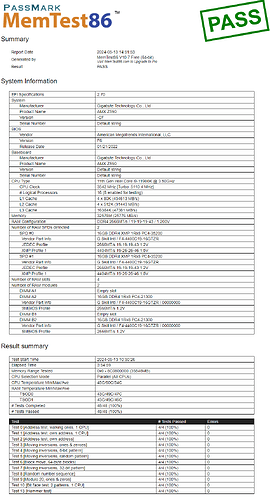I have confirmed that the RAM kit is F4-4400C19D-32GTZR, which is not on the QVL. Memtest is halfway through its third pass, still no errors.
Here’s my plan going forward:
First thing’s first, if I need to replace the RAM, I will. I already assume that this is necessary, but if you magicians know of some kind of workaround to get XMP stable with the incompatible RAM, that’d be sweet.
Then, I will check the rev # of the motherboard to see whether it’s the same as the retail board, as well as do a fully overkill CMOS reset like you suggested. I might even replace the battery, too. Even if the rev # is not the same, I might still risk the flash anyways since I have the secondary BIOS.
Then, I will perform a clean install of windows 11, install ME firmware, install CSME Tools v15.4 (I believe the ME firmware provided on the support page is v15.4, will double check when I’m at this stage, of course), and run those FPT commands to create backups of the primary and secondary BIOS as well as the MAC addresses of the ethernet ports. Do I have to install all of the motherboard drivers again to do this? Maybe just the chipset drivers? I would love to wait until I flash the new BIOS before installing any of the motherboard drivers, since there are far newer ones available on the actual support page for the Z590 XTREME. I’ll do what must be done, though.
Also, to use the FPT tool do I need to disable memory integrity or anything else like that? I’m running Windows 11 “Pro” for what it’s worth. I think I might also order a hardware programmer just in case, which one would you recommend?
If all of this looks good and I haven’t missed anything, I will go through with it and hopefully report back some time later in the week.
EDIT:
My PC currently has ME v15.0, guess I’ll be rocking with that one.
I found some old DDR4 lying around, some Corsair vengeance LPX stuff I had in a previous build. Model is CMK16GX4M2B3200C16 ver4.32, which is not on the QVL, but there is a similar set on the QVL sheet, “CMK32GX4M2B3200C16 ver5.39,” but it’s listed on the sheet as a 2x8GB kit, when the actual model number depicts a 2x16GB kit on Corsair’s website, so I’m not sure. Could be worth a shot, maybe? At this point, what even truly matters when it comes to RAM compatibility? GIGABYTE seemingly can’t even represent the different sets of RAM correctly on the QVL sheet, they’ve got 32 gig kits listed as only 16GB, and they’ve got 32GB kits listed as “2Rx8,” when they should be “2Rx16,” no? Correct me if I’m wrong on this.
Also, here are the memtest results:
